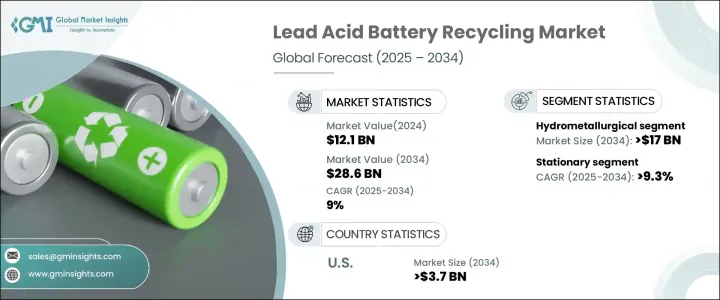 |
市场调查报告书
商品编码
1684672
铅酸电池回收市场机会、成长动力、产业趋势分析与预测 2025 - 2034Lead Acid Battery Recycling Market Opportunity, Growth Drivers, Industry Trend Analysis, and Forecast 2025 - 2034 |
||||||
全球铅酸电池回收市场价值 121 亿美元,2024 年预计将大幅成长,预计 2025 年至 2034 年的复合年增长率为 9%。回收过程通常包括拆卸电池组件、提取铅及其化合物、中和硫酸以及重新利用塑胶外壳以备将来使用。随着各行各业都优先考虑永续性,有效的回收解决方案的重要性不断受到关注,使得这个市场成为全球环境策略的重要组成部分。

人们越来越意识到不当电池处理带来的环境风险,这是市场扩张的主要动力。如果不加以负责任地管理,铅和硫酸会严重污染土壤和水,造成长期的生态和健康危害。回收可以减轻这些危险,并最大限度地减少对新的铅开采的需求,铅开采是一项以能源密集和环境破坏性而闻名的活动。透过重新使用铅和塑胶等有价值的材料,回收过程进一步符合全球永续发展目标。随着政府监管的不断加强以及消费者对绿色实践的倡导,全球范围内铅酸电池回收的采用正在加速。
| 市场范围 | |
|---|---|
| 起始年份 | 2024 |
| 预测年份 | 2025-2034 |
| 起始值 | 121亿美元 |
| 预测值 | 286亿美元 |
| 复合年增长率 | 9% |
湿式冶金製程正在成为业界变革的一大因素,预计到 2034 年将创造 170 亿美元的产值。其更高的材料产量,加上能源效率和成本效益,正在推动其在回收设施中的广泛应用。随着行业倾向于可持续和高产量的回收方法,湿式冶金製程预计将在未来几年占据主导地位。
随着对可靠能源储存解决方案的需求不断增长,到 2034 年,回收铅酸电池的固定应用将以 9.3% 的强劲复合年增长率成长。这些电池对于备用电源系统和再生能源应用(包括太阳能和风能储存)至关重要。先进回收技术的开发确保了延长电池寿命和提高成本效率,从而促进了其在固定应用中的采用。随着电池回收领域的不断创新,製造商正在将更多的回收材料融入他们的产品中,进一步支持产业成长。
在美国,铅酸电池回收市场预计到 2034 年将创造 37 亿美元。住宅、商业和工业领域对能源储存解决方案的需求不断增长,特别是对备用电源和再生能源整合的需求,正在推动市场扩张。这些趋势凸显了电池回收产业对永续性和高效资源利用的日益重视。
目录
第 1 章:方法论与范围
- 市场定义
- 基础估算与计算
- 预测计算
- 初步研究与验证
- 主要来源
- 资料探勘来源
- 市场定义
第 2 章:执行摘要
第 3 章:产业洞察
- 产业生态系统
- 监管格局
- 产业衝击力
- 成长动力
- 产业陷阱与挑战
- 成长潜力分析
- 波特的分析
- PESTEL 分析
第四章:竞争格局
- 介绍
- 战略仪表板
- 创新与技术格局
第 5 章:市场规模及预测:依製程分类,2021 年至 2034 年
- 主要趋势
- 火法冶金
- 湿式冶金
- 物理/机械
第 6 章:市场规模与预测:按应用,2021 – 2034 年
- 主要趋势
- 星光
- 固定式
- 其他的
第 7 章:市场规模及预测:按地区,2021 – 2034 年
- 主要趋势
- 北美洲
- 我们
- 加拿大
- 欧洲
- 英国
- 西班牙
- 德国
- 法国
- 亚太地区
- 中国
- 韩国
- 日本
- 印度
- 世界其他地区
第八章:公司简介
- Amara Raja
- Aqua Metals
- Cirba Solutions
- East Penn Manufacturing Company
- EnerSys
- Exide
- Glencore
- GME Recycling
- Gravita India
- Umicore
- Yuasa Battery
The Global Lead Acid Battery Recycling Market, valued at USD 12.1 billion in 2024, is poised for significant growth, with projections indicating a 9% CAGR from 2025 to 2034. This dynamic market centers on the collection and processing of used lead acid batteries (ULABs) to recover essential materials, including lead, sulfuric acid, and plastic. The recycling process typically involves dismantling battery components, extracting lead and its compounds, neutralizing sulfuric acid, and repurposing plastic casings for future use. As industries prioritize sustainability, the importance of effective recycling solutions continues to gain traction, making this market a critical component of global environmental strategies.

The rising awareness of the environmental risks associated with improper battery disposal is a major driver of market expansion. Lead and sulfuric acid, if not managed responsibly, can severely contaminate soil and water, posing long-term ecological and health hazards. Recycling mitigates these dangers and minimizes the need for new lead mining, an activity known for its energy-intensive and environmentally damaging nature. By reusing valuable materials, such as lead and plastic, the recycling process further aligns with global sustainability goals. With increasing government regulations and consumer advocacy for greener practices, the adoption of lead acid battery recycling is accelerating worldwide.
| Market Scope | |
|---|---|
| Start Year | 2024 |
| Forecast Year | 2025-2034 |
| Start Value | $12.1 Billion |
| Forecast Value | $28.6 Billion |
| CAGR | 9% |
The hydrometallurgical process is emerging as a game-changer in the industry, projected to generate USD 17 billion by 2034. Offering notable environmental and economic advantages, this method ensures efficient recovery of lead and other valuable metals like cobalt and nickel. Its higher material yield, combined with energy efficiency and cost-effectiveness, is driving widespread adoption among recycling facilities. As the industry leans towards sustainable and high-yield recycling methods, hydrometallurgical processes are expected to dominate in the coming years.
Stationary applications of recycled lead acid batteries are set to grow at a robust CAGR of 9.3% through 2034, driven by increasing demand for reliable energy storage solutions. These batteries are critical for backup power systems and renewable energy applications, including solar and wind energy storage. The development of advanced recycling technologies, ensuring extended battery lifecycles and cost-efficient processes, is bolstering their adoption in stationary applications. As innovations in battery recycling continue, manufacturers are integrating more recycled materials into their products, further supporting industry growth.
In the United States, the lead acid battery recycling market is projected to generate USD 3.7 billion by 2034. This growth is underpinned by stringent environmental regulations mandating responsible battery disposal and recycling. The rising demand for energy storage solutions across residential, commercial, and industrial sectors, particularly for backup power and renewable energy integration, is fueling market expansion. These trends highlight the growing emphasis on sustainability and efficient resource utilization in the battery recycling sector.
Table of Contents
Chapter 1 Methodology & Scope
- 1.1 Market definitions
- 1.2 Base estimates & calculations
- 1.3 Forecast calculation
- 1.4 Primary research & validation
- 1.4.1 Primary sources
- 1.4.2 Data mining sources
- 1.5 Market definitions
Chapter 2 Executive Summary
- 2.1 Industry synopsis, 2021 – 2034
Chapter 3 Industry Insights
- 3.1 Industry ecosystem
- 3.2 Regulatory landscape
- 3.3 Industry impact forces
- 3.3.1 Growth drivers
- 3.3.2 Industry pitfalls & challenges
- 3.4 Growth potential analysis
- 3.5 Porter's analysis
- 3.5.1 Bargaining power of suppliers
- 3.5.2 Bargaining power of buyers
- 3.5.3 Threat of new entrants
- 3.5.4 Threat of substitutes
- 3.6 PESTEL analysis
Chapter 4 Competitive landscape, 2024
- 4.1 Introduction
- 4.2 Strategic dashboard
- 4.3 Innovation & technology landscape
Chapter 5 Market Size and Forecast, By Process, 2021 – 2034 (USD Billion)
- 5.1 Key trends
- 5.2 Pyrometallurgical
- 5.3 Hydrometallurgical
- 5.4 Physical/Mechanical
Chapter 6 Market Size and Forecast, By Application, 2021 – 2034 (USD Billion)
- 6.1 Key trends
- 6.2 SLI
- 6.3 Stationary
- 6.4 Others
Chapter 7 Market Size and Forecast, By Region, 2021 – 2034 (USD Billion)
- 7.1 Key trends
- 7.2 North America
- 7.2.1 U.S.
- 7.2.2 Canada
- 7.3 Europe
- 7.3.1 UK
- 7.3.2 Spain
- 7.3.3 Germany
- 7.3.4 France
- 7.4 Asia Pacific
- 7.4.1 China
- 7.4.2 South Korea
- 7.4.3 Japan
- 7.4.4 India
- 7.5 Rest of World
Chapter 8 Company Profiles
- 8.1 Amara Raja
- 8.2 Aqua Metals
- 8.3 Cirba Solutions
- 8.4 East Penn Manufacturing Company
- 8.5 EnerSys
- 8.6 Exide
- 8.7 Glencore
- 8.8 GME Recycling
- 8.9 Gravita India
- 8.10 Umicore
- 8.11 Yuasa Battery










